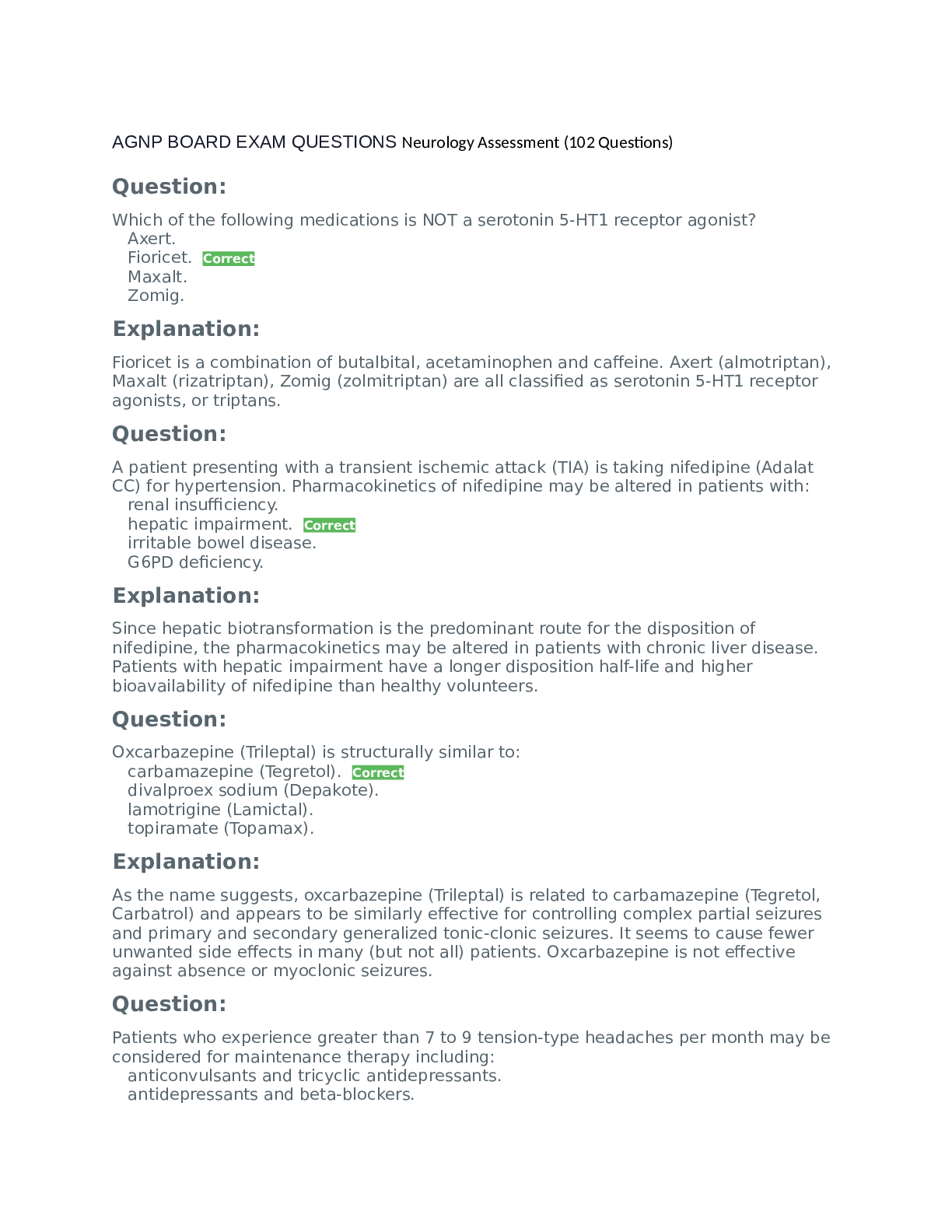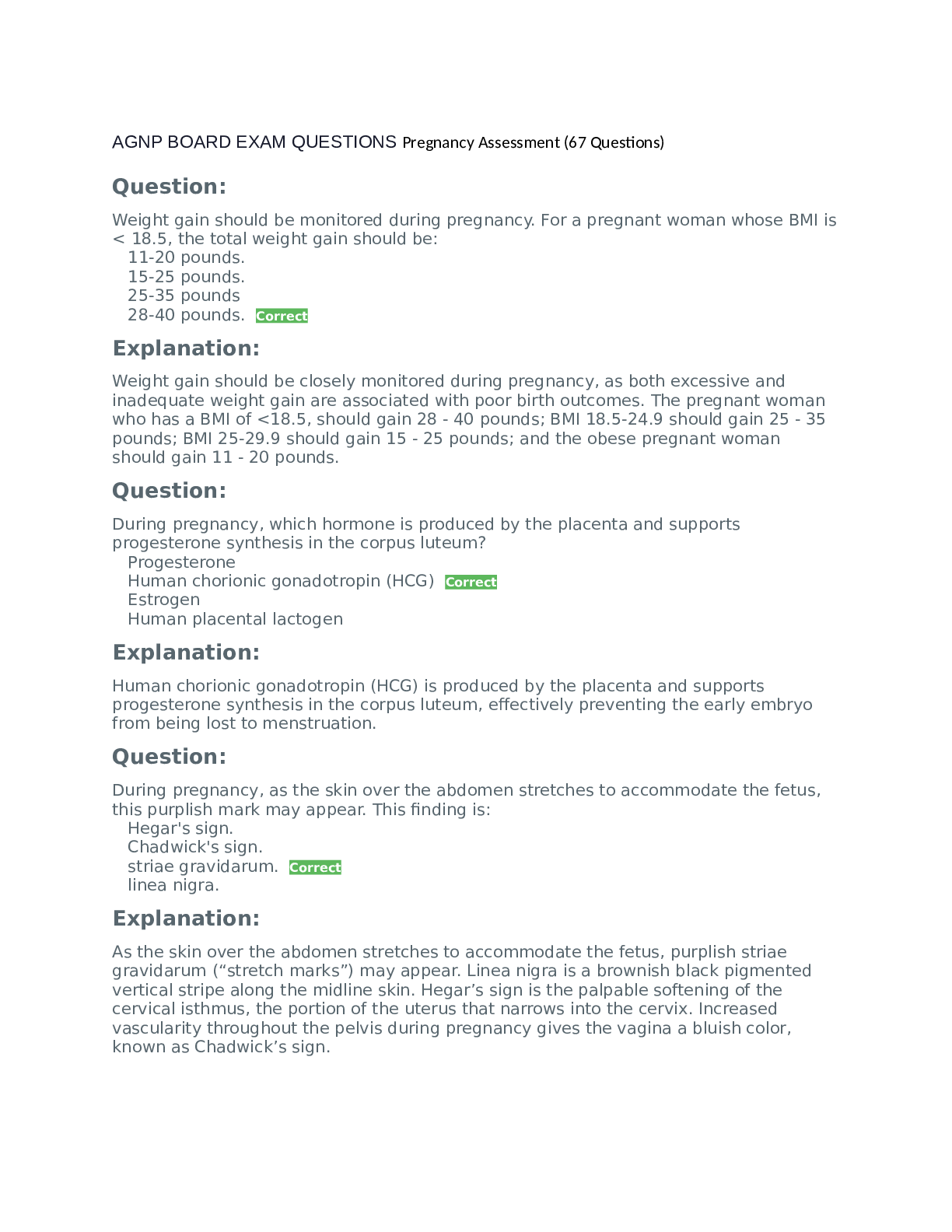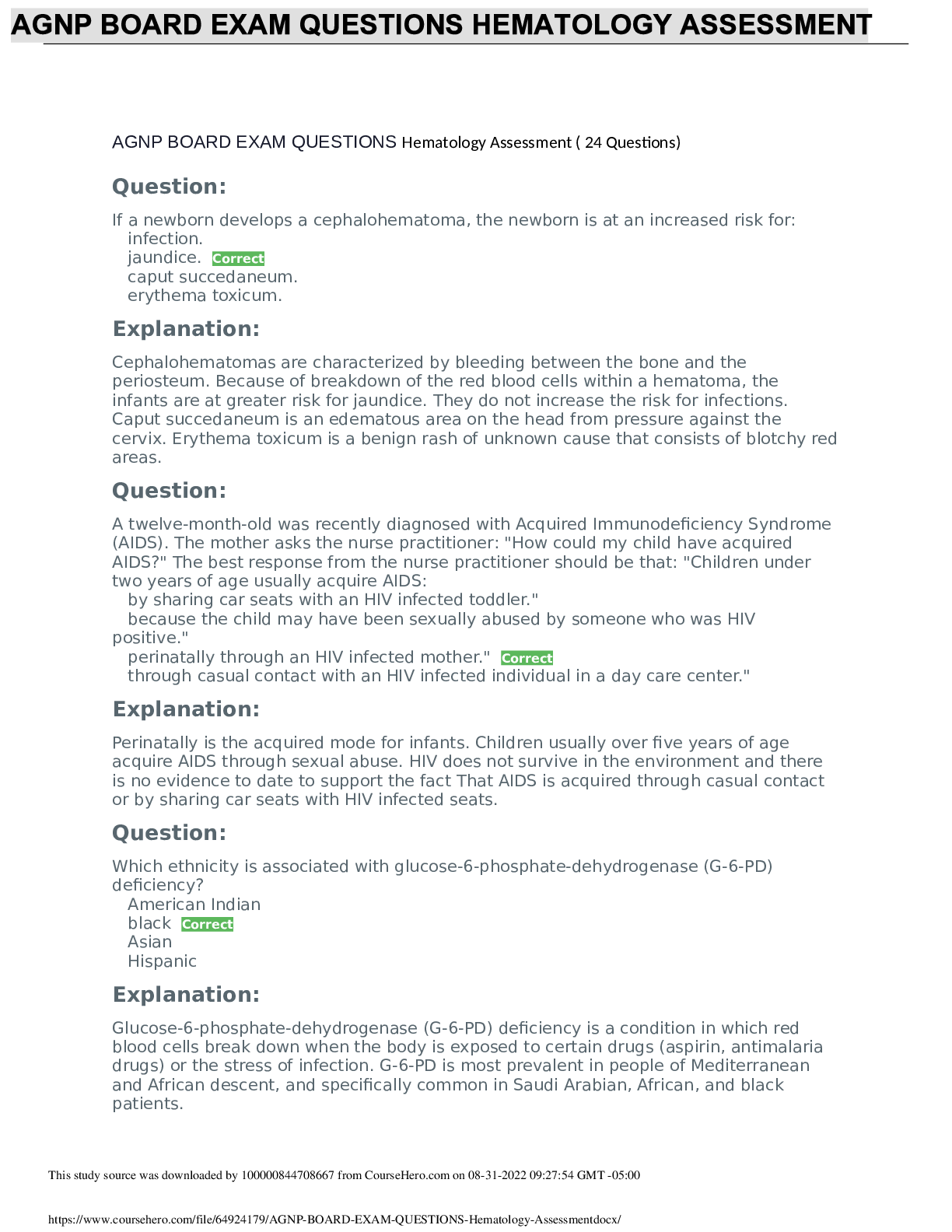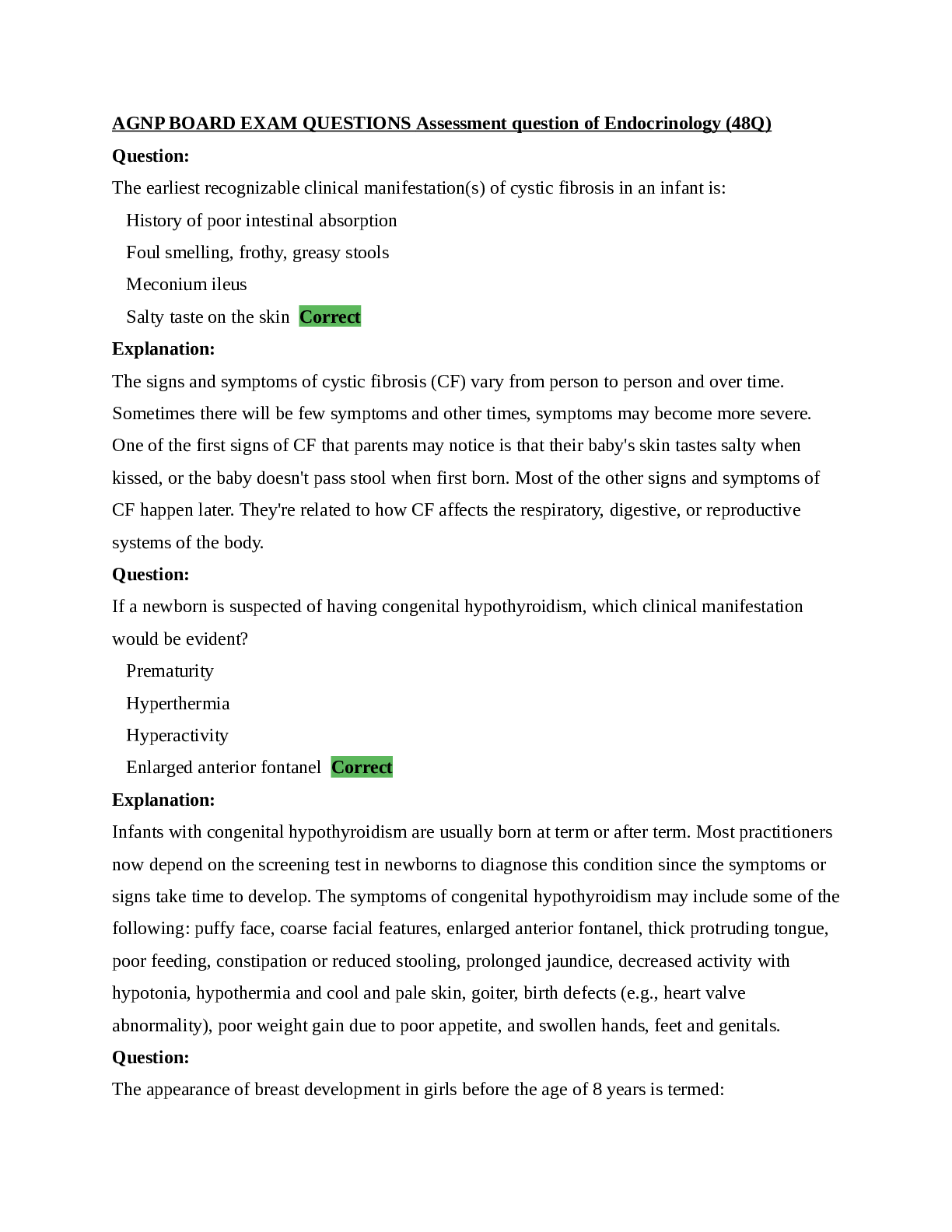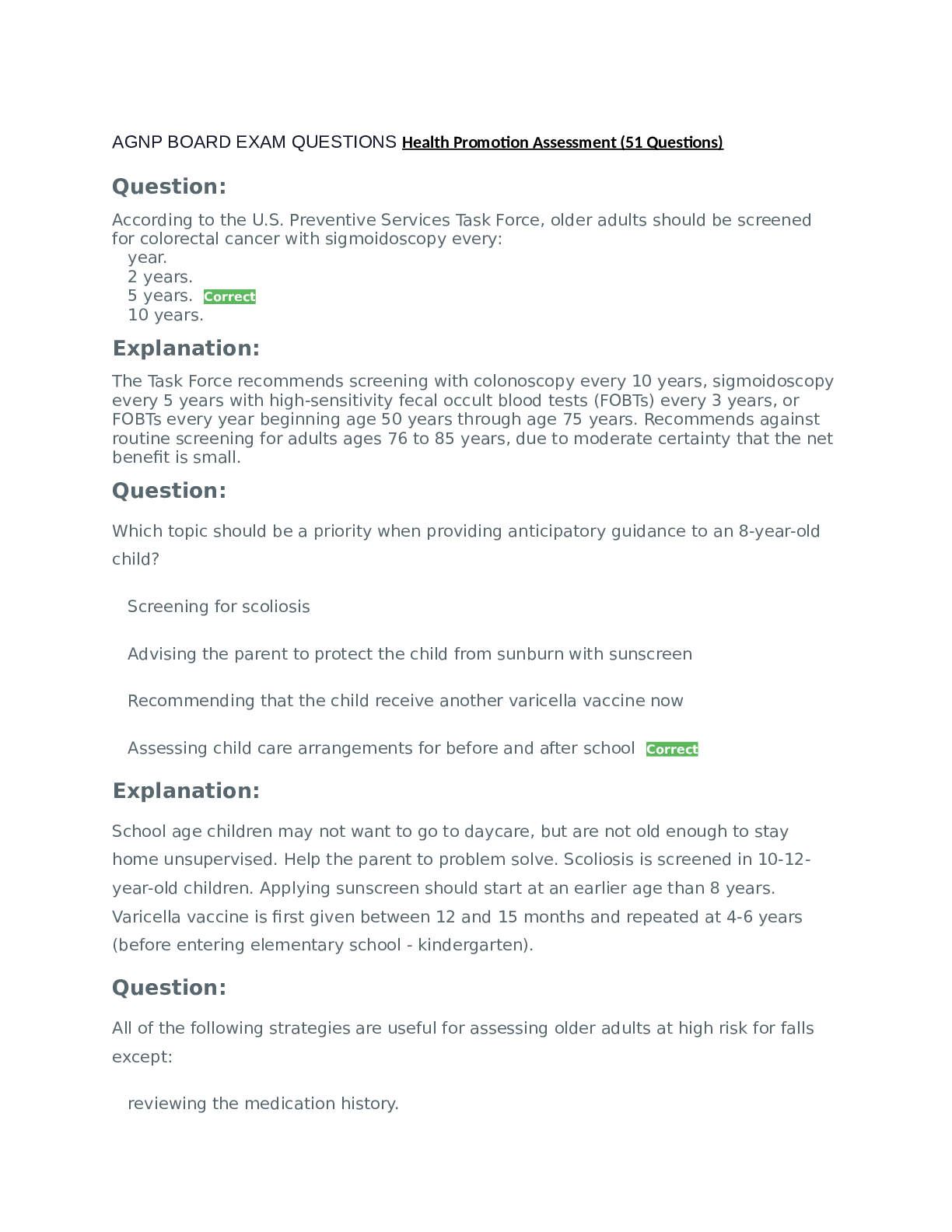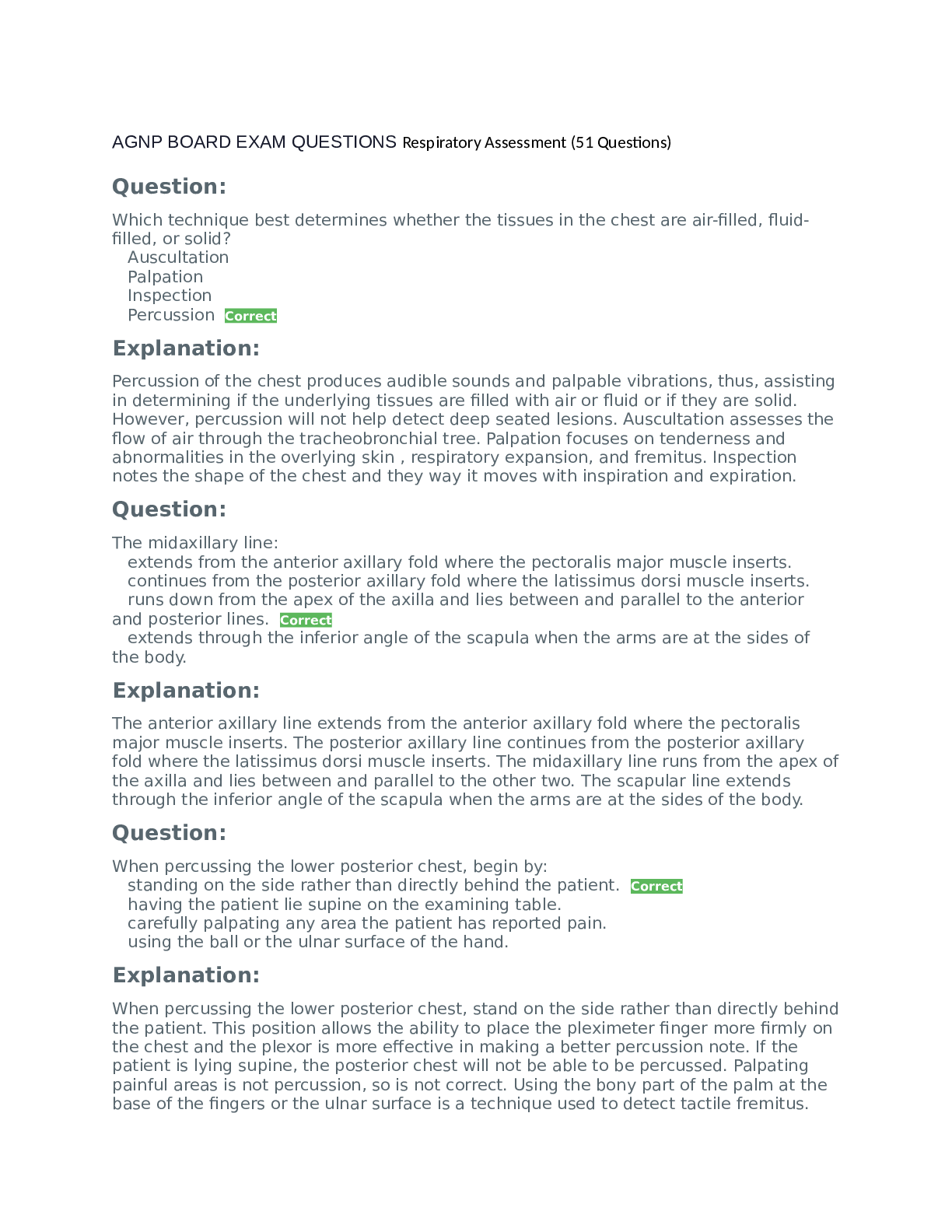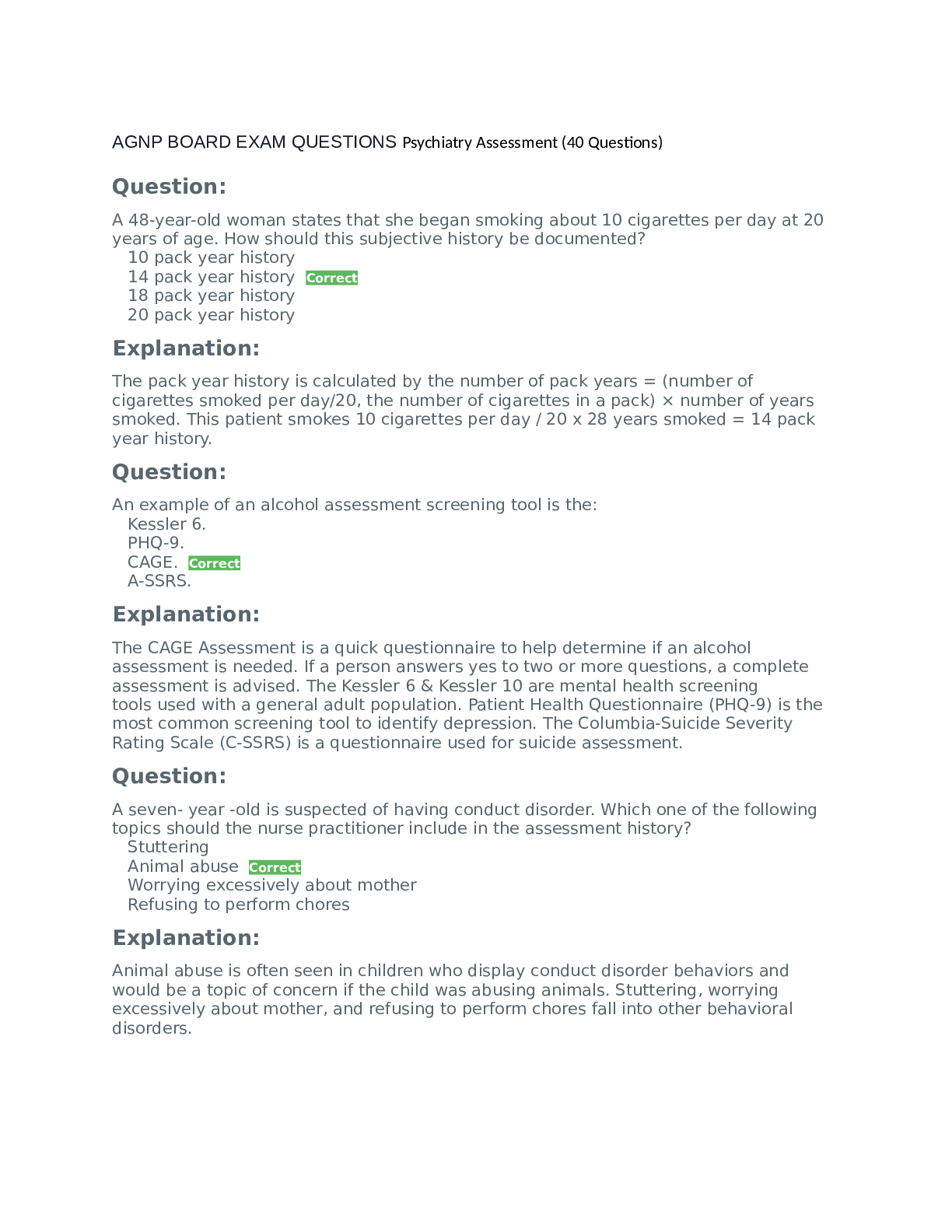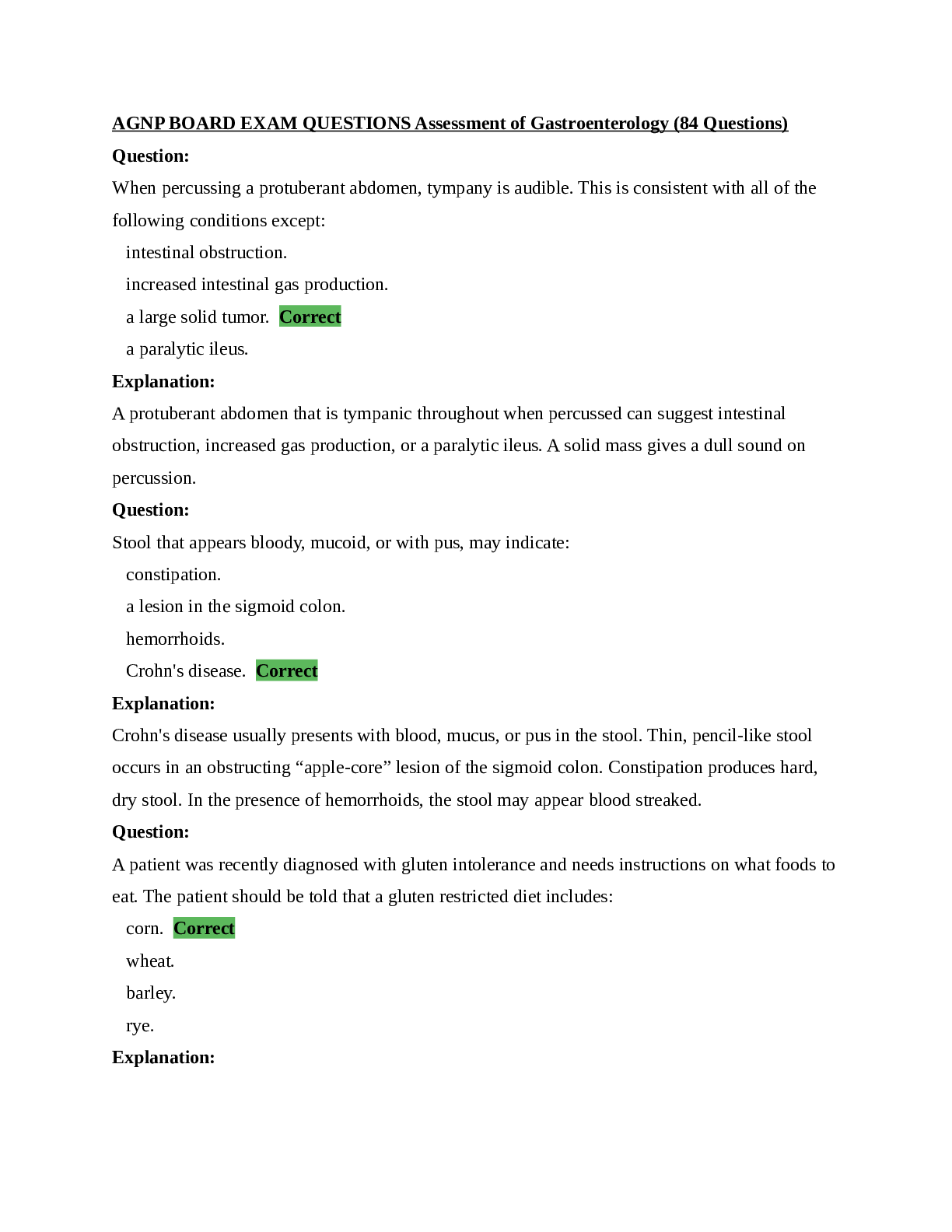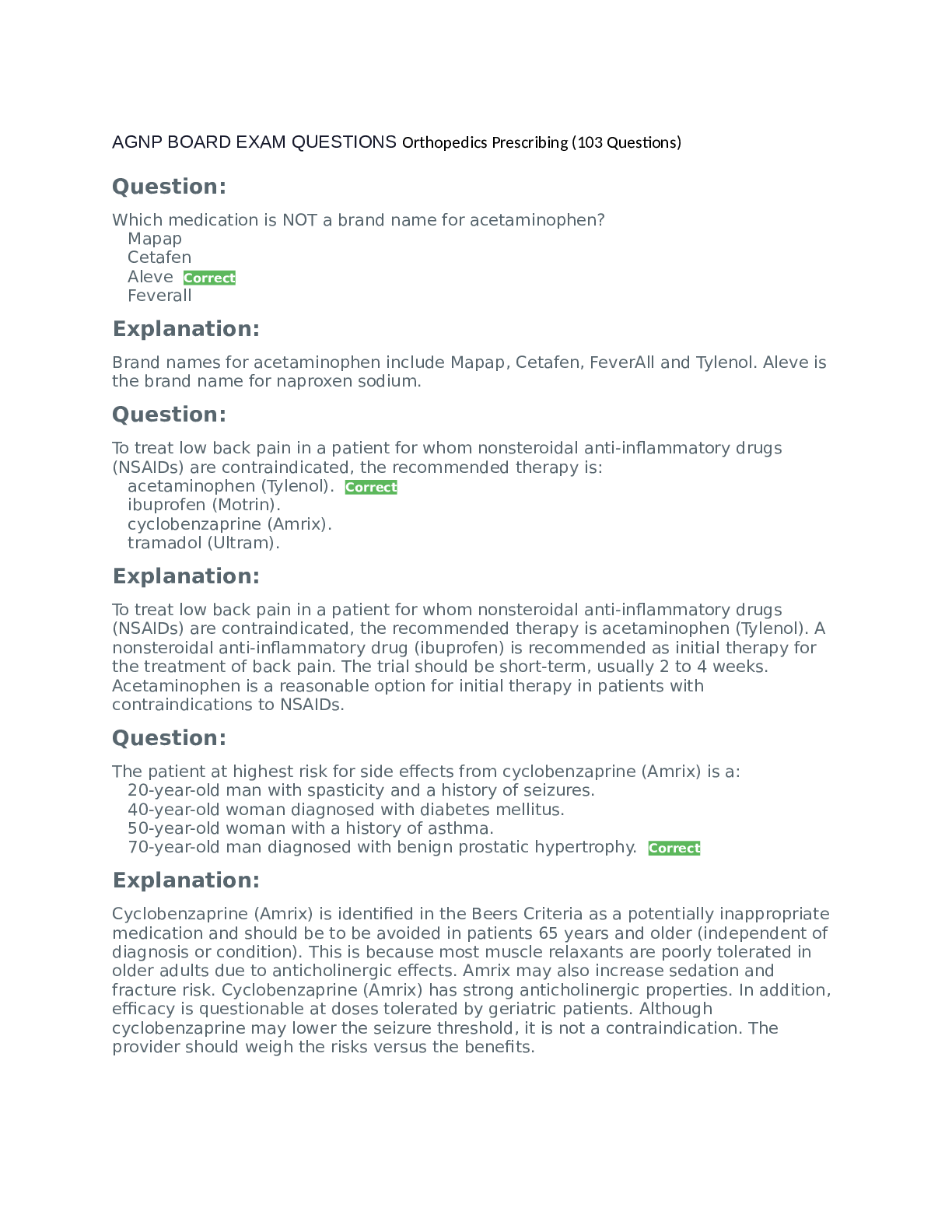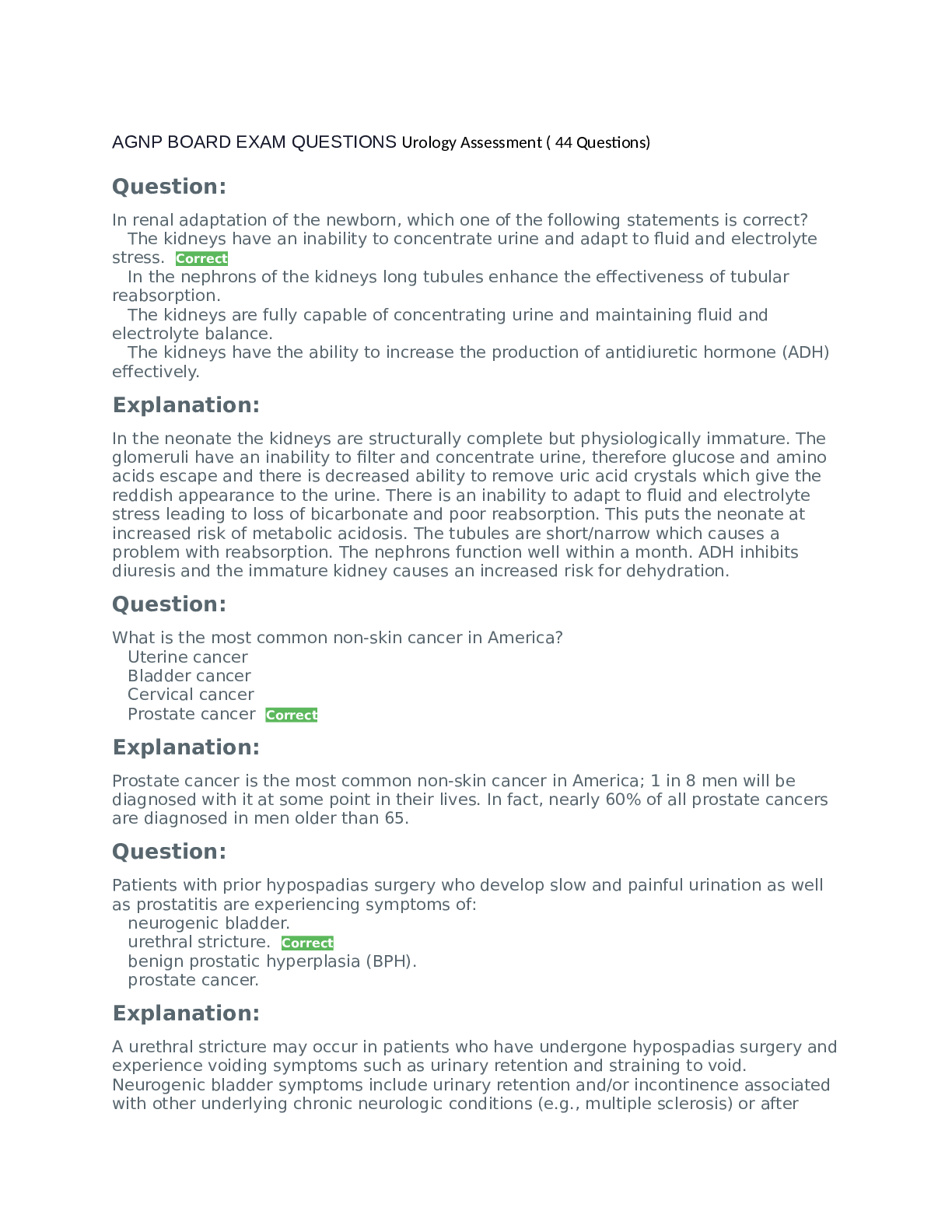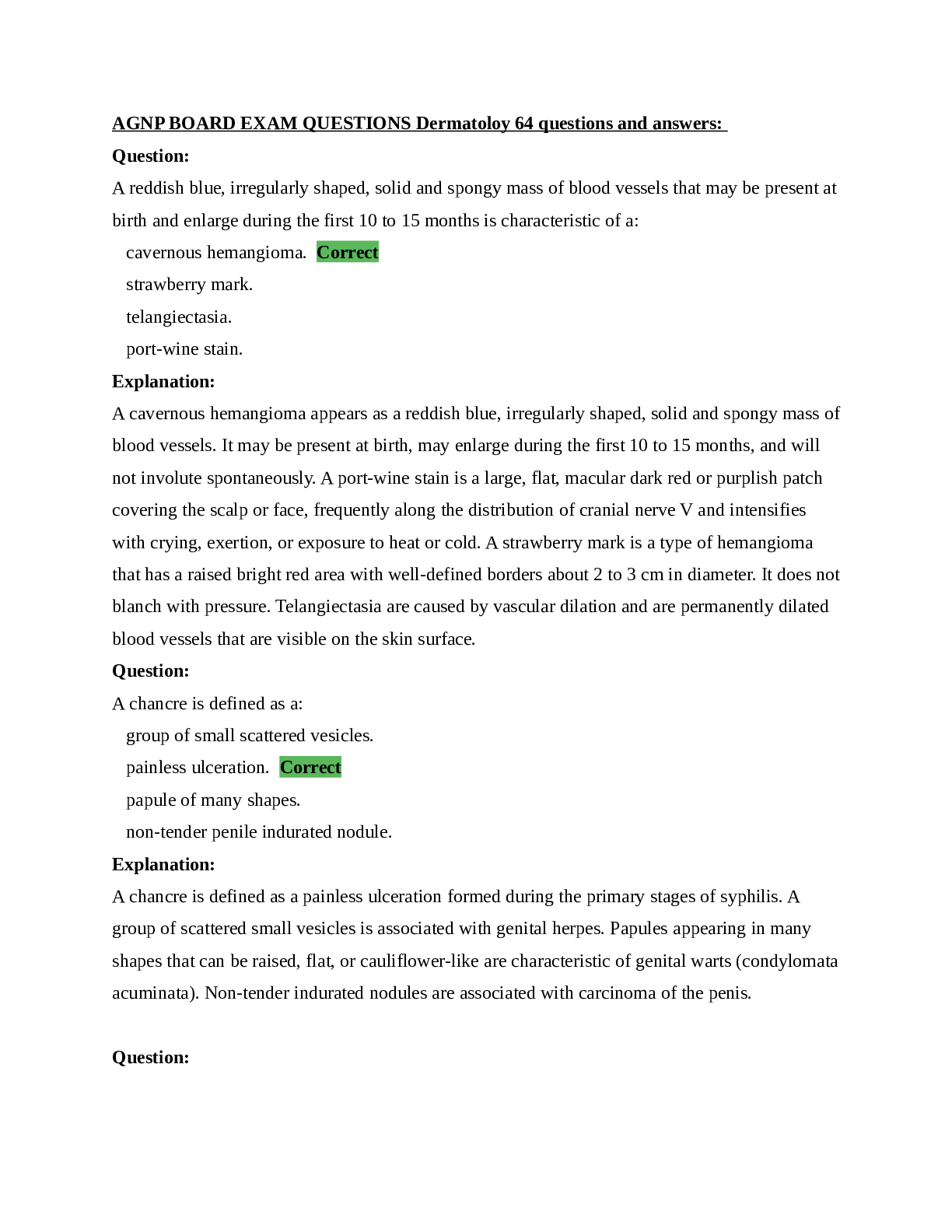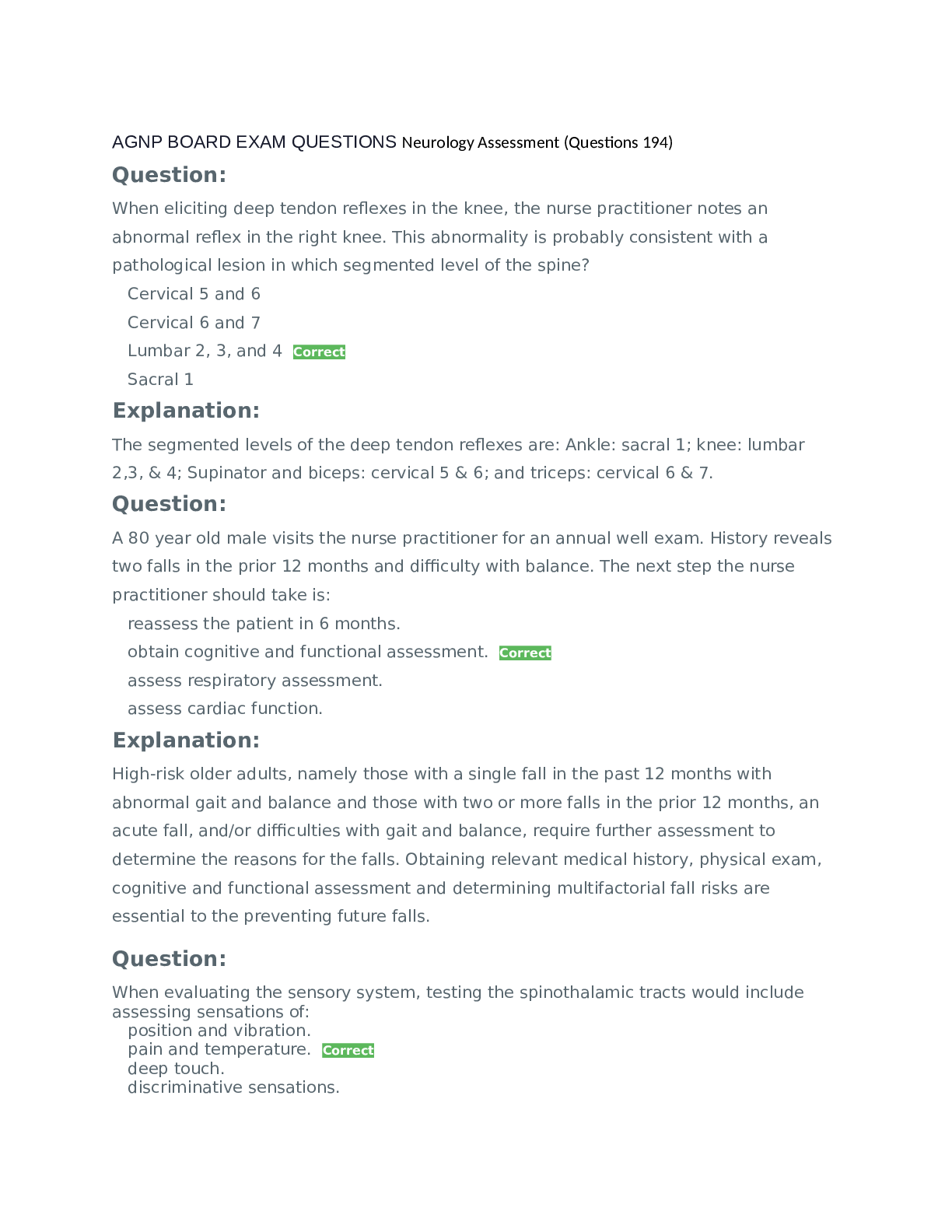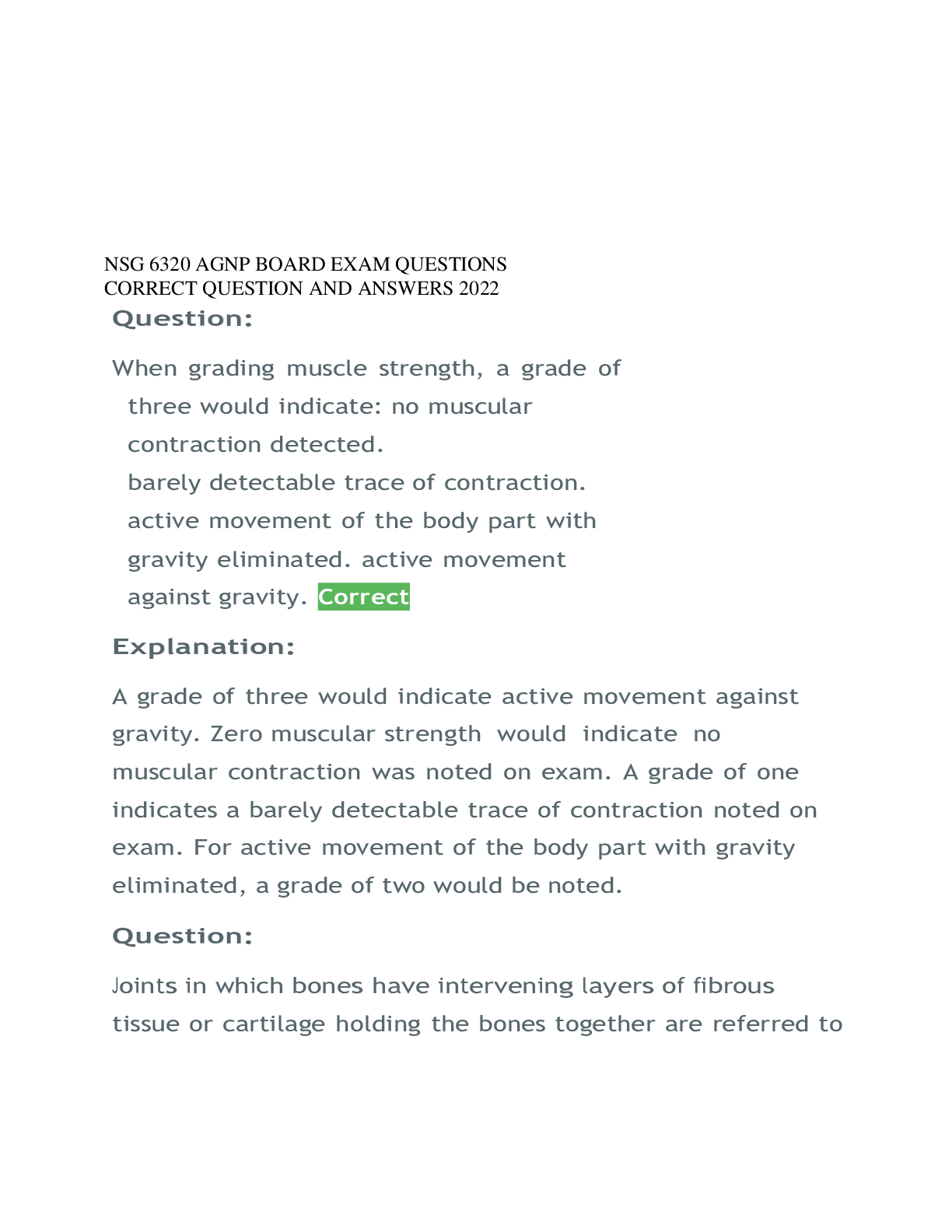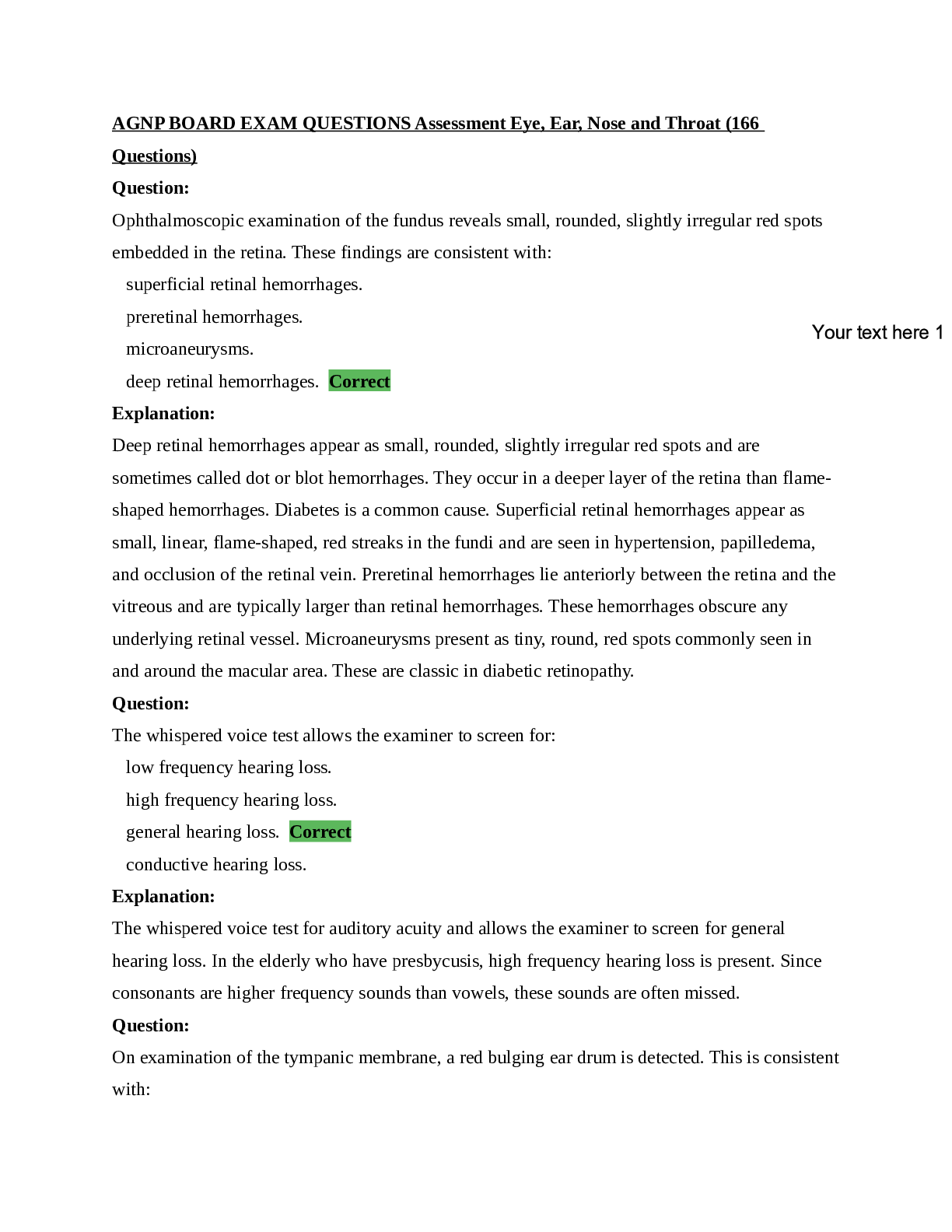*NURSING > QUESTIONS & ANSWERS > South University, Savannah NSG 6320 AGNP BOARD EXAM QUESTIONS EYE EAR NOSE THROAT Prescription Alrea (All)
South University, Savannah NSG 6320 AGNP BOARD EXAM QUESTIONS EYE EAR NOSE THROAT Prescription Already Passed
Document Content and Description Below
AGNP BOARD EXAM QUESTIONS EYE EAR NOSE THROAT Prescription (102 Questions) Question: Oral tetracycline (Sumycin), for the treatment of acute frontal sinusitis, should be administered: with milk. ... with meals. on an empty stomach. Correct with an antacid. Explanation: Tetracycline (Sumycin) should be administered on an empty stomach (i.e., 1 hour prior to, or 2 hours after meals) to increase total absorption and with adequate amount of fluid to reduce the risk of esophageal irritation and ulceration. It should be administered at least 1 to 2 hours prior to, or 4 hours after, an antacid containing aluminum and magnesium cations. It may chelate with tetracycline (Sumycin) and reduce its total absorption. Serum concentrations may be decreased if taken with dairy products. Question: The brand name for sulfacetamide ophthalmic is: AzaSite. Bleph-10. Correct Besivance. Garamycin. Explanation: The brand name of sulfacetamide ophthalmic is Bleph-10. AzaSite is the brand name of azithromycin. Besifloxacin is the generic name for Besivance. The generic name of Garamycin is gentamicin sulfate. Question: The generic name for Polytrim ophthalmic is: trimethoprim and polymyxin B. Correct bacitracin/polymyxin B. azithromycin. besifloxacin. Explanation: The generic name for Polytrim is trimethoprim and polymyxin B. Polycin is the brand name for bacitracin/polymyxin B. The brand name for azithromycin is AzaSite. Besifloxacin brand name is Besivance. Question: Which of the following does NOT cause a drug-disease interaction when using a decongestant/antihistamine medication such as Naphazoline/pheniramine (Naphcon-A)? Cardiovascular disease Angle-closure glaucoma Prostatic hypertrophy Hypothyroidism Correct Explanation: Contraindications/cautions when using naphazoline/pheniramine (Naphcon-A) include angleclosure glaucoma, MAOI inhibitor use within 14 days, cardiovascular disease, hypertension, diabetes mellitus, prostatic hypertrophy and urinary tract obstruction. Question: The maximum daily dose of acetaminophen for ages 12 years and older is: 1200 milligrams/day. 2000 milligrams/day. 3000 milligrams/day. 4000 milligrams/day. Correct Explanation: Acetaminophen generally is safe to use. In high doses, however, it can cause liver damage. Doses of 4000 mg (4 grams) per day should not be exceeded in patients 12 years and older. Maximum dose in neonates is 60 mg/kg/day and 75 mg/kg/day in infants and children. Question: For treatment of blepharitis, patients should be instructed to apply erythromycin ointment to the affected eye using: a 0.5 inch ribbon 3 times daily for 5 days. a 0.5 cm ribbon 3 times daily for 5 days. a 1-inch ribbon 5 times daily for 7 days. a 1-cm ribbon 5 times daily for 7 days. Correct Explanation: Patients should be instructed to apply a 1-cm ribbon of erythromycin ophthalmic ointment up to 6 times daily for up to 10 days. Question: Ophthalmic cromolyn inhibits the degranulation of sensitized mast cells. It is indicated in the treatment of: acute conjunctivitis. vernal conjunctivitis. Correct fungal keratitis. herpes keratoconjunctivitis. Explanation: Ophthalmic cromolyn is a mast cell stabilizer used to prevent or control allergic conditions. It is indicated in the treatment of vernal keratoconjunctivitis, vernal conjunctivitis, and vernal keratitis. Vernal conjunctivitis is long-term inflammation of the outer lining of the eyes. It is due to an allergic reaction. Question: The most effective treatment for eradication of group A streptococcus in those who are apparent carriers is: a single dose of intramuscular penicillin (Bicillin). oral rifampin (Rifadin) for 4 days. oral clindamycin (Cleocin) for 10 days. Correct a single dose of intramuscular ceftriaxone (Rocephin). Explanation: The most effective treatment for eradication of group A streptococcus in those who are carriers is oral clindamycin (Cleocin) for 10 days. A single dose of intramuscular penicillin (Bicillin) plus 4 days of oral rifampin (Rifadin) is also effective. Question: The generic name for Dramamine is: doxylamine. diphenhydramine. brompheniramine. dimenhydrinate. Correct Explanation: The generic name of Dramamine is dimenhydrinate. Question: For empiric treatment of patients with acute bacterial rhinosinusitis (ABRS) who are allergic to penicillin, the best alternative first-line therapy is: azithromycin (Zithromax). clarithromycin (Biaxin). doxycycline (Vibramycin). Correct metronidazole (Flagyl). Explanation: Doxycycline (100 mg orally twice daily or 200 mg orally daily) is a reasonable alternative for first-line therapy and can be used in patients with penicillin allergy. A respiratory fluoroquinolone (levofloxacin 500 mg orally or moxifloxacin 400 mg orally once daily) is another alternative for penicillin-allergic patients. However, fluoroquinolones should be reserved for those who have no alternative treatment options, because the serious adverse effects associated with fluoroquinolones generally outweigh the benefits for patients with acute sinusitis. Macrolides (clarithromycin or azithromycin), trimethoprim-sulfamethoxazole, and second- or third-generation cephalosporins are not recommended for empiric therapy because of high resistance rates of S. pneumoniae. Question: Dosing of oseltamivir (Tamiflu) for adults and adolescents with active influenza is administered orally: based on weight twice daily for 5 days. 75 mg daily x 5 days. 75 mg twice daily x 5 days. Correct 75 mg twice daily x 10 days. Explanation: Dosing of oseltamivir (Tamiflu) for adults and adolescents with active influenza is 75 mg twice daily for 5 days. No dosage adjustment is necessary in the morbidly obese patient. Prophylactic dosing of oseltamivir (Tamiflu) for adults and adolescents who have been exposed to influenza is 75 mg by mouth daily x 10 days. Question: The vasoconstrictive properties of alpha-1 agonist medications make them beneficial for the treatment of: benign prostatic hypertrophy. closed-angle glaucoma. sinus congestion. Correct hypertension. Explanation: Because of their properties as vasoconstrictive agents, alpha-1 agonists are used to reduce edema and inflammation within the sinus cavities. Alpha-1 agonist medications are also known as decongestants. Common decongestant drugs include phenylephrine (Neo-Synephrine) and oxymetazoline (Afrin) nasal. Question: The use of oral acyclovir (Zovirax) in older adults is more likely to cause: confusion and hallucinations. Correct constipation and hypertension. headache and peripheral edema. increased liver enzyme activity. Explanation: Older adults are more likely to have renal or CNS adverse events when receiving acyclovir (Zovirax). With respect to CNS adverse events observed during clinical practice, somnolence, hallucinations, confusion, and coma are reported more frequently in older adults. The most frequently reported side effects are malaise, headache, nausea, vomiting and diarrhea. Cardiovascular side effects have not been reported. Increased liver enzyme activity may occur with parenteral administration. Question: Cephalosporins are classified as: macrolides. beta-lactam antibiotics. Correct non beta-lactam antibiotics. aminoglycosides. Explanation: Beta-lactam antibiotics are among the most commonly prescribed drugs, grouped together based upon a shared structural feature, the beta-lactam ring. Beta-lactam antibiotics include penicillins, cephalosporins, carbapenems, monobactams, and beta-lactamase inhibitors. Question: The onset of action of oxymetazoline (Afrin) is: 5 minutes. 10 minutes. Correct 30 minutes. 60 minutes. Explanation: Oxymetazoline (Afrin) has an onset of action of 10 minutes and a duration of action of 12 hours. Oxymetazoline is a decongestant that shrinks blood vessels in the nasal passages. Indicated for short-term temporary relief of nasal congestion. Do not use in larger or smaller amounts or for longer than recommended. Overuse may cause rebound congestion. Recommended dosing is 2-3 sprays in each nostril every 10-12 hours as needed. Question: Erythromycin (Ilotycin) ophthalmic ointment is classified as a(n): aminoglycoside. macrolide. Correct fluoroquinolone. sulfonamides. Explanation: Erythromycin (Ilotycin) ophthalmic ointment is classified as a macrolide. Ofloxacin ophthalmic is a fluoroquinolone. Gentamicin ophthalmic is an aminoglycoside. Sulfacetamide ophthalmic is a sulfonamide. Question: A common side effect of amoxicillin in children is: nausea. joint pain. abdominal pain. Correct headache. Explanation: The most common side effects in children who take amoxicillin are abdominal pain or cramps, black tarry stools, diarrhea, chest pain and bleeding gums. Hypersensitivity reactions are a major problem with the use of penicillins such as amoxicillin (Amoxil). Symptoms of hypersensitivity reactions include adverse reaction resulting in nausea, vomiting, pruritus, urticaria, wheezing, laryngeal edema and ultimately, ca [Show More]
Last updated: 1 year ago
Preview 1 out of 39 pages
Instant download

Instant download
Reviews( 0 )
Document information
Connected school, study & course
About the document
Uploaded On
Apr 22, 2022
Number of pages
39
Written in
Additional information
This document has been written for:
Uploaded
Apr 22, 2022
Downloads
0
Views
205

.png)
.png)
.png)
.png)
.png)
.png)
.png)
.png)
.png)
.png)
.png)

.png)
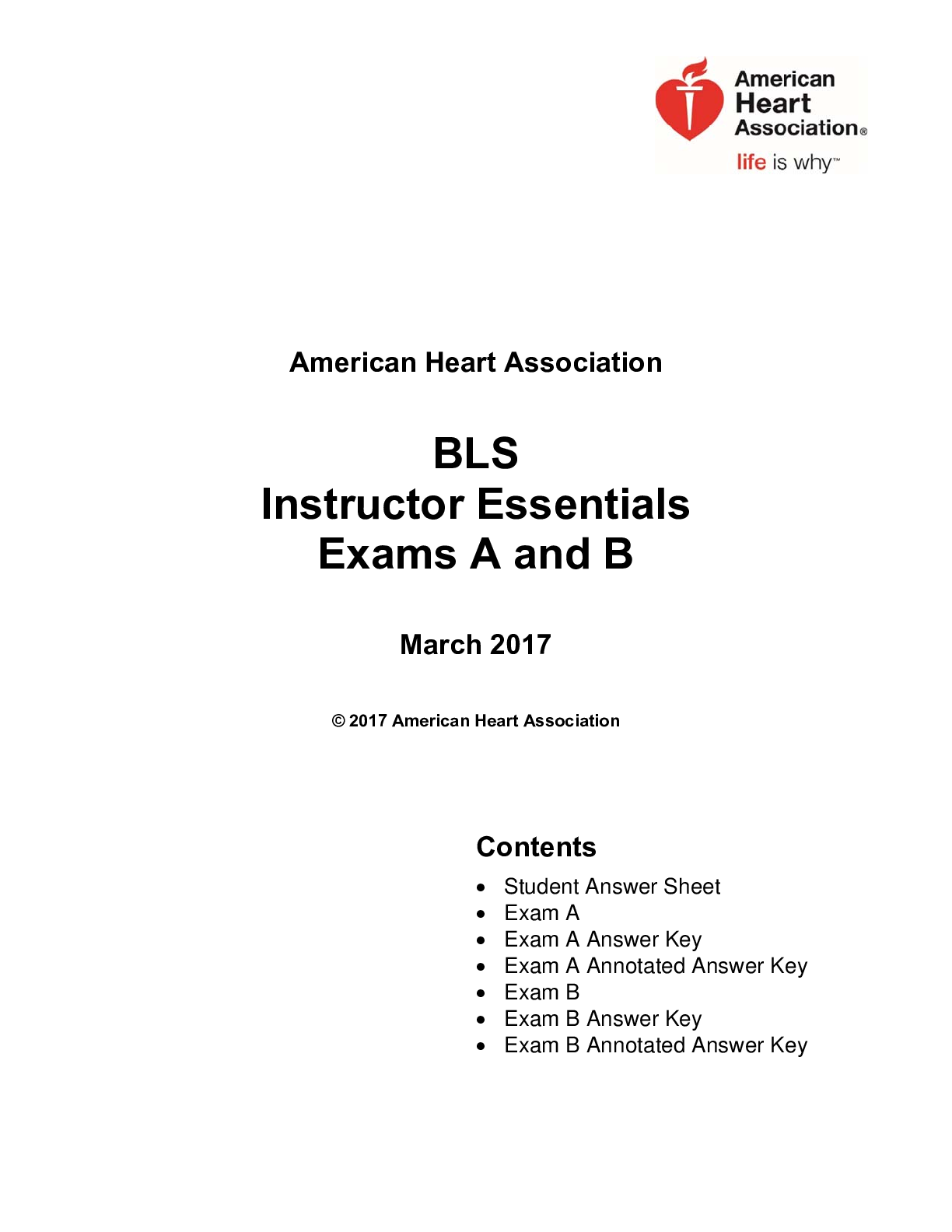
.png)
.png)

